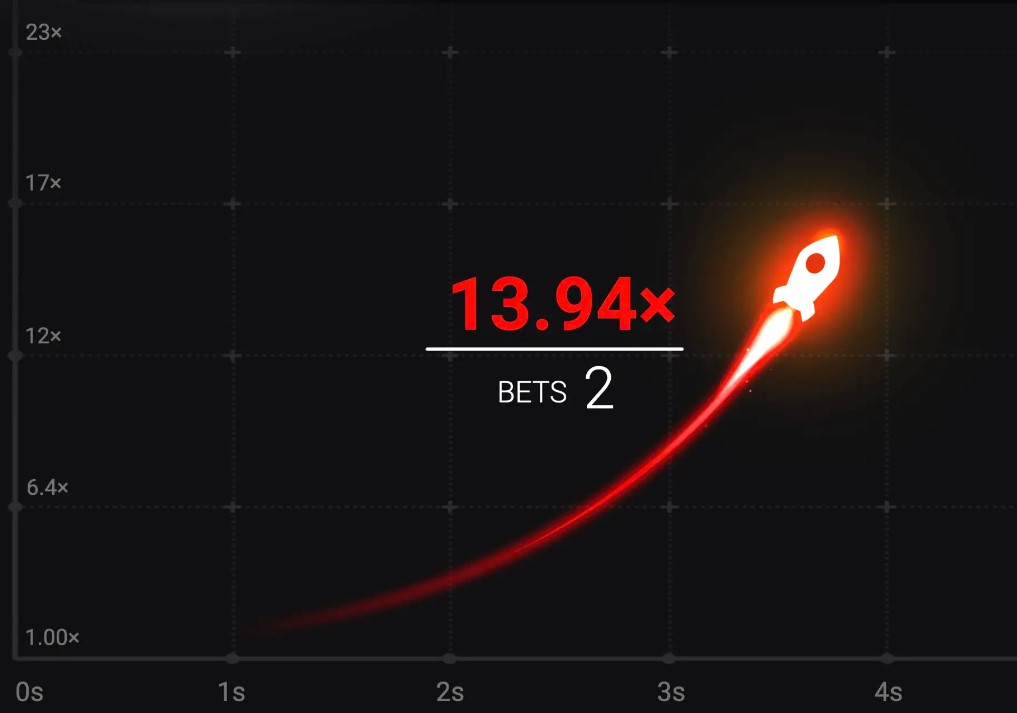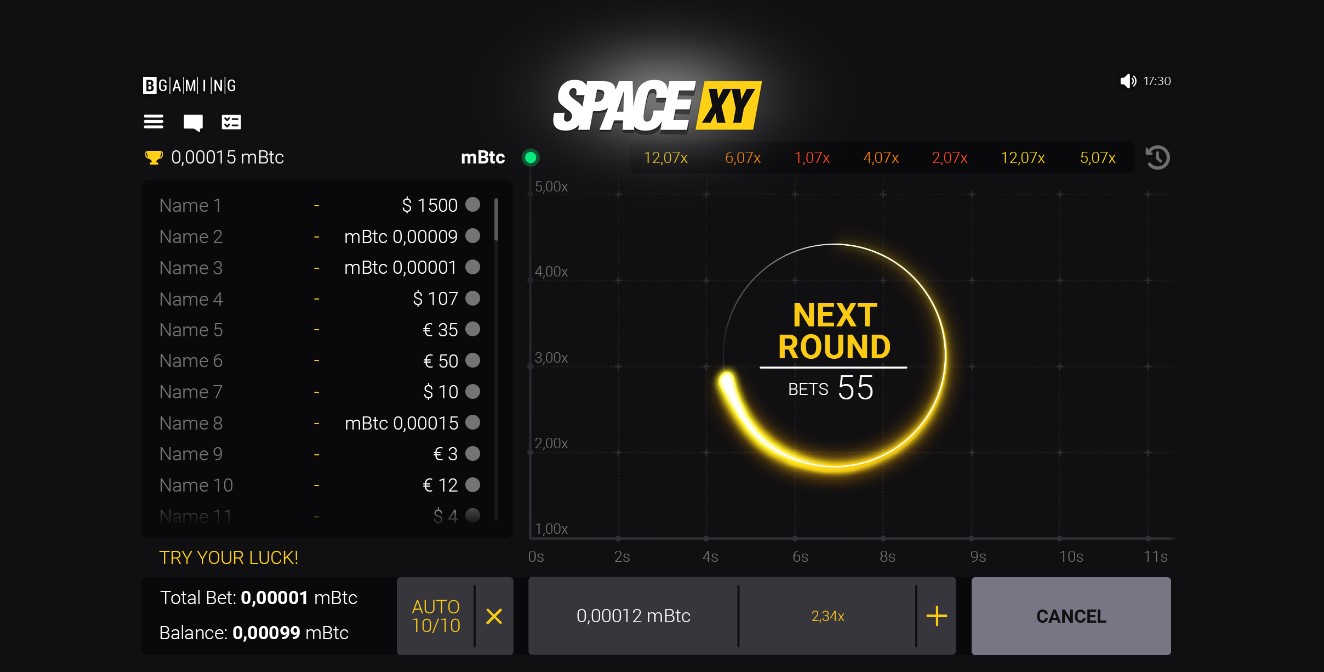Space XY is a thrilling new crash game from BGaming that takes you on an adventure to the stars. With its stunning visuals, immersive gameplay, and generous payouts, casino game Space XY slot is sure to keep you entertained for hours on end.

reviews SpaceXY games
SpaceXY Review
| Feature | Details |
| Game name | Space XY |
| Developer | BGaming |
| Type of game | Crash game |
| Gameplay | Players bet on an increasing multiplier. If they cash out before the multiplier crashes, they win the amount multiplied by their bet. If the multiplier crashes before they cash out, they lose their bet. |
| RTP | 96.01% |
| Max payout | 100x your bet |
| Availability | Desktop, mobile, and tablet devices |
Pros and cons
Here are some of the pros and cons of the Space XY crash game:
Pros:
- Simple but addictive gameplay
- Stunning visual design and immersive gameplay
- Generous payouts, with the potential to win up to 100x your bet
- Available to play on desktop, mobile, and tablet devices
Cons:
- High-risk, high-reward game
- Can be addictive
- Easy to lose money if you’re not careful
Overall, Space XY is a fun and potentially lucrative crash game. However, it’s important to remember that it is a high-risk game, so only bet what you can afford to lose.

demo game SpaceXY
Game features
Here are some of the game features of Space XY:
- Multiplier: The multiplier starts at 1x and increases by 0.01 for every 0.01 second that passes. The longer you wait to cash out, the higher your multiplier will be, but the greater the risk that the game will crash.
- Cash out: To cash out, simply click on the «Cash Out» button. If the multiplier crashes before you cash out, you will lose your bet. But if you cash out at the right time, you could win big!
- Auto cash out: You can also set an auto cash out amount. This will automatically cash you out when the multiplier reaches a certain value.
- Multiple bets: You can place multiple bets on the same game. This will increase your chances of winning, but it will also increase your risk.
- Autoplay: You can set the game to autoplay for a certain number of rounds. This is a great way to play the game hands-free.
- Rocket play: This feature allows you to make bets and watch how your rocket launches into space on the graph. The higher your bet, the higher your rocket will go. If your rocket reaches the top of the graph, you will win the jackpot!
Best casinos to play Space XY for real money
Here are some of the best casinos to play Space XY for real money:
- PariMatch
- 1xBet
- Winz.io
- Bets.io
- National Casino
When choosing an online casino to play Space XY for real money, it is important to consider the following factors:
- Reputation
- Security
- Game selection
- Bonuses and promotions
- Customer support

game SpaceXY online
What is SpaceXY casino game?
Space XY is a crash game developed by BGaming. It is a simple but addictive game where players bet on an increasing multiplier. If they cash out before the multiplier crashes, they win the amount multiplied by their bet. If the multiplier crashes before they cash out, they lose their bet.
Space XY is a high-risk, high-reward game. The potential payouts are very high, but the risk of losing is also very high. Players should only bet what they can afford to lose.
Here are some of the features of Space XY:
- Simple but addictive gameplay: The gameplay is simple to understand, but it can be very addictive.
- High-risk, high-reward: The potential payouts are very high, but the risk of losing is also very high.
- Stunning visual design: The game has a stunning visual design that will immerse you in the game.
- Available to play on desktop, mobile, and tablet devices: You can play Space XY on your desktop, mobile, or tablet device.
If you are looking for a simple but addictive casino game with high potential payouts, then Space XY is a great option. However, it is important to remember that it is a high-risk game, so only bet what you can afford to lose.
How to bet and play SpaceXY slot?
Here are the steps on how to bet and play SpaceXY slot:
- Choose an online casino that offers SpaceXY slot.
- Make a deposit into your casino account.
- Navigate to the SpaceXY slot game.
- Select your bet amount.
- Click the «Spin» button.
- Watch the rocket ship move diagonally upwards.
- Cash out before the multiplier crashes.
If the rocket reaches the point where you bet before it crashes, you win the amount multiplied by your bet. If the rocket crashes before it reaches your point, you lose your bet.

game SpaceXY playing casino
How it works
The game is played on a grid with a rocket ship moving diagonally upwards. The multiplier starts at 1x and increases by 0.01 for every 0.01 second that passes. Players can bet on any point on the grid. If the rocket reaches the point where they bet before it crashes, they win the amount multiplied by their bet. If the rocket crashes before it reaches their point, they lose their bet.
Space XY is a high-risk, high-reward game. The potential payouts are very high, but the risk of losing is also very high. Players should only bet what they can afford to lose.
Tips and Tricks for Playing
Here are some additional tips for playing SpaceXY slot:
- Start with a small bet and gradually increase your bets as you get more comfortable with the game.
- Set a loss limit and stick to it.
- Take breaks if you’re starting to feel frustrated or emotional.
- Remember, gambling should be fun and never a way to make money. If you find yourself struggling with gambling, please seek help from a professional.
Here are some of the strategies that you can use when playing SpaceXY slot:
- The Martingale strategy: This strategy involves doubling your bet after every loss. This can be a risky strategy, but it can also be very profitable if you’re lucky.
- The Fibonacci strategy: This strategy involves betting a sequence of numbers from the Fibonacci sequence after every loss. This is a less risky strategy than the Martingale strategy, but it can also be less profitable.
- The Labouchere strategy: This strategy involves creating a sequence of numbers and then betting the sum of the first and last number in the sequence after every loss. This is a less risky strategy than the Martingale strategy, but it can also be less profitable.
It is important to remember that there is no guaranteed way to win at SpaceXY slot. These strategies are just guidelines that you can use to improve your chances of winning.

how to bet slot SpaceXY
Mobile app for SpaceXY Bet
As of today, there is no mobile app for SpaceXY Bet. The game is only available to play on desktop devices.
However, there are a few ways to play SpaceXY Bet on mobile devices. One way is to use a mobile browser to access the SpaceXY Bet website. Another way is to use a mobile casino app that offers SpaceXY Bet.
Bonuses in Space XY Bet
Space XY Bet does not offer any bonuses specifically for the Space XY game. However, there are a number of general bonuses that players can take advantage of.
Here are some of the bonuses that are available at Space XY Bet:
- Welcome bonus: This is a bonus that is offered to new players when they make their first deposit. The welcome bonus can vary from casino to casino, but it typically includes a match bonus and free spins.
- Reload bonus: This is a bonus that is offered to existing players when they make a deposit. The reload bonus can also vary from casino to casino, but it typically includes a match bonus.
- Free spins: Free spins are a type of bonus that gives players the opportunity to spin the reels of a slot machine without having to risk any of their own money. Free spins can be offered as part of a welcome bonus, reload bonus, or as a standalone promotion.
- Cashback bonus: A cashback bonus is a type of bonus that gives players a percentage of their losses back in the form of bonus money. Cashback bonuses are typically offered on a weekly or monthly basis.
- VIP program: Many casinos offer VIP programs to their most loyal players. VIP programs typically come with a number of benefits, such as exclusive bonuses, faster payouts, and personal customer service.
It is important to read the terms and conditions of any bonus before you claim it. This will ensure that you understand the wagering requirements and other restrictions that apply to the bonus.

mega win game SpaceXY
Demo mode
Here are the steps on how to play Space XY in demo mode:
- Choose an online casino that offers Space XY in demo mode.
- Navigate to the Space XY game.
- Select the «demo» option.
- You will then be able to play the game using virtual currency.
- Any winnings that you earn in demo mode will not be real money and cannot be withdrawn.
- To exit demo mode, simply click the «exit» button.
Here are some of the benefits of playing Space XY in demo mode:
- You can try out the game without risking any of your own money.
- You can learn the rules of the game and practice your skills.
- You can get a feel for the game’s volatility and RTP.
- You can use demo mode to test out different betting strategies.
If you are new to Space XY or online gambling in general, I recommend playing in demo mode first. This will allow you to learn the ropes and to find the betting strategies that work best for you.
Here are some of the drawbacks of playing Space XY in demo mode:
- You cannot win any real money.
- The experience may not be as immersive as playing for real money.
- Some casinos may limit the number of times that you can play Space XY in demo mode.

SpaceXY game online
SpaceXY Predictor
SpaceXY Predictor is a website that claims to be able to predict the outcome of Space XY games. The website uses a variety of factors, including historical data, current trends, and mathematical algorithms, to make its predictions.
SpaceXY Predictor is not a reliable way to predict the outcome of Space XY games. There is no scientific evidence to support the claims that the website makes. In fact, many people believe that SpaceXY Predictor is a scam.
If you are considering using SpaceXY Predictor, I recommend that you do your own research and that you be very cautious. There is a high risk that you will lose money if you use this website.
Here are some of the reasons why SpaceXY Predictor is not a reliable way to predict the outcome of Space XY games:
- The website uses a variety of factors that are not always accurate. For example, the website may use historical data that is outdated or that is not relevant to the current game.
- The website’s mathematical algorithms may not be accurate. The website may use algorithms that are not based on sound mathematical principles.
- The website’s predictions may be biased. The website may be owned by someone who has a vested interest in the outcome of Space XY games.
If you are looking for a way to predict the outcome of Space XY games, I recommend that you use a different method. There are a number of websites that offer free prediction services. You can also use your own judgment and experience to make your own predictions.
Reviews about it
Here are some reviews about Space XY:
- «Space XY is a great game for those who are looking for a high-risk, high-reward experience. The game is simple to play, but it can be very addictive. I’ve had some great wins playing Space XY, but I’ve also had some big losses. Overall, I think it’s a great game, but it’s important to only bet what you can afford to lose.»
- «Space XY is a fun and exciting game, but it’s important to remember that it’s a gamble. You can win big, but you can also lose big. I would recommend playing Space XY in demo mode first to get a feel for the game before you play for real money.»
- «Space XY is a great game, but it’s important to be careful. The game is very addictive and it’s easy to lose track of how much money you’re spending. I would recommend setting a budget before you start playing and sticking to it.»

SpaceXY game slot
Conclusion
Space XY is a fun and exciting game, but it is important to remember that it is a gamble. You can win big, but you can also lose big. I would recommend playing Space XY in demo mode first to get a feel for the game before you play for real money.
If you are considering playing Space XY for real money, I recommend that you do your own research and that you be very cautious. There is a high risk that you will lose money if you play this game.
FAQ
What is the RTP of Space XY?
The RTP of Space XY is 96.01%. This means that for every $100 that is bet on Space XY, the player can expect to win $96.01 on average.
What is the max win in Space XY?
The max win in Space XY is 100x your bet. This means that if you bet $100 on Space XY, you can win a maximum of $10,000.
Is Space XY a fair game?
Space XY is a fair game. The game is provably fair, which means that the results of each game can be verified by the player.
How do I play Space XY?
To play Space XY, simply select the amount you want to bet and click the «Spin» button. The multiplier will start at 1x and increase by 0.01 for every 0.01 second that passes. You can cash out at any time by clicking the «Cash Out» button. If the multiplier crashes before you cash out, you will lose your bet.
